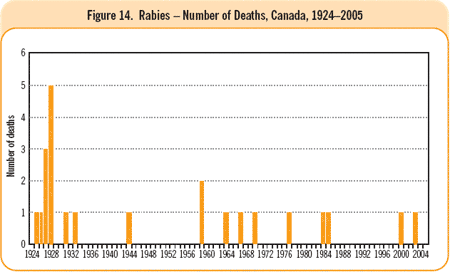Common menu bar links
Institutional links
Diseases & Conditions
Health & Safety
Research & Statistics
Agency Information
Search Box
E-mail this page
Vaccine-Preventable Diseases
Rabies
Rabies is a neurotropic viral infection that has two clinical presentations and is a fatal disease. After infection, the usual incubation period is 20 to 60 days, although it may vary from several days to years. The more common, agitated (furious) form presents with the classic symptoms of hydrophobia or aerophobia with a rapidly progressing encephalitis and death. The paralytic form of the disease manifests as progressive flaccid paralysis, has a more protracted course and is more difficult to diagnose.
Epidemiology
Human rabies
In 2000 and 2003, two people in Canada died of rabies infection, one in Quebec (2000) and one in British Columbia (2003). These were the first cases of human rabies in Canada since 1985. The most likely sources of infection for both of these people were unrecognized bat exposures. Since 1924, a total of 23 people in six provinces have died of rabies in Canada (Figure 14): Quebec (12), Ontario (6), Saskatchewan (2) and Alberta, British Columbia and Nova Scotia (1 case each). In 2004, the US Centers for Disease Control and Prevention confirmed the first reported case of rabies following solid organ transplantation.
Animal rabies
The rabies virus can infect any mammal. In North America, it occurs mainly in certain wild terrestrial carnivore species and can spread to domestic livestock and pets. Over the past few years the overall number of animal rabies cases in Canada has been steadily decreasing. There remain regional differences in the prevalence of animal rabies across the country, and the specific species infected in each region vary over time. For up-to-date details on animal rabies activity in Canada, please see the Canadian Food Inspection Agency (CFIA) Web site (http://www.inspection.gc.ca/english/anima/heasan/disemala/rabrag/statse.shtml).
During the past 6 years (2000-2005) a total of 2,238 cases of confirmed animal rabies were reported in Canada (average: 373 per year). Skunks accounted for 40% of the total cases, followed by bats (26%), foxes (11%) and raccoons (8%). Bat rabies was detected in most regions across Canada, except the three territories and Prince Edward Island (PEI). Three provinces accounted for the majority of cases: Ontario (43%), Manitoba (24%) and Saskatchewan (14%). The species most affected, by region, during the 6-year period were as follows: skunks in Manitoba (434/540 or 80%) and Saskatchewan (243/316 or 77%); bats in British Columbia (91/95 or 96%), Alberta (20/21 or 95%) and Quebec (66/118 or 56%); foxes in the Northwest Territories/Nunavut (57/74 or 77%) and Newfoundland/Labrador (33/44 or 75%); and raccoons in New Brunswick (55/70 or 79%). In Ontario the most affected species were bats (356/956 or 37%) and skunks (226/ 956 or 24%). Over the past 6 years, PEI reported one case of animal rabies (cat), and Nova Scotia reported three. Yukon had no reported cases of animal rabies. Spread to domestic species of animals, such as pets (e.g., cats and dogs) and livestock (horses and cows) has occurred. Dogs and cats accounted for 4.5% of animal rabies cases.
Bat rabies has accounted for 58% of the human rabies cases in the United States since 1980 and appears to be increasing in frequency. The increased incidence is due, in part, to the failure to recognize the small wound inflicted by a biting bat and thus omission of post-exposure prophylaxis. In most of the recently reported cases, there has not been a history of a bat bite although there has been contact, either recognized or unrecognized at the onset of the illness, with infected colonies. In the past, four cases were thought to have been acquired through aerosolized virus across mucous membranes.
Source: Canadian Immunization Guide, 7th edition, 2006
Links to more information
Guidelines and Recommendations
- For information about Rabies vaccine, see the Canadian Immunization Guide, 7th edition 2006
Travel Medicine Program

